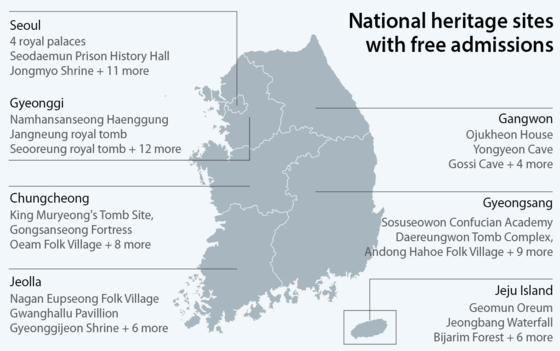Cultural Heritage Administration celebrates name change with free entry to historical sites
-

- YIM SEUNG-HYE
- yim.seunghye@joongang.co.kr
![Gyeongbok Palace in central Seoul and dozens of other Korea heritage sites across the country will have free admission from Wednesday to Sunday. [YONHAP]](https://koreajoongangdaily.joins.com/data/photo/2024/05/15/e92330ef-c66d-4490-bc9d-7ec9d10fe263.jpg)
Gyeongbok Palace in central Seoul and dozens of other Korea heritage sites across the country will have free admission from Wednesday to Sunday. [YONHAP]
Korea’s four royal palaces and Jongmyo Shrine in central Seoul as well as 75 other cultural heritage sites scattered across the country, such as Daereungwon Ancient Tombs in Gyeongju, Hwaseong Haenggung in Suwon and Seongsan Ilchulbong in Jeju, will be open to the public for free from Wednesday for five days. This is to promote the name change of the Cultural Heritage Administration, a government agency that is responsible for preserving and promoting Korean heritage. The administration will be known as the Korea Heritage Service (KHS), a change set to take effect from Friday.
Other heritage sites you can visit for free in Seoul during the five days include Gyeongbok Palace, Changdeok Palace, Deoksu Palace and Changgyeong Palace — excluding the Secret Garden of Changgyeong Palace. The Amsa-dong Prehistoric Settlement Site in Gangdong District, Seodaemun Prison History Hall and the royal tombs will also allow free entry.

![Namhansanseong Haenggung in Gwangju City, Gyeonggi [JOONGANG ILBO]](https://koreajoongangdaily.joins.com/data/photo/2024/05/15/288bbec2-1470-47af-ac3f-238c7fddd8c6.jpg)
Namhansanseong Haenggung in Gwangju City, Gyeonggi [JOONGANG ILBO]
For the Gyeonggi region, Namhansanseong Haenggung in Gwangju and more royal tombs in Gyeonggi, such as Jangneung in Gimpo and Seooreung in Goyang, are also included. As for Gangwon, Ojukheon House in Gangneung, Yongyeon Cave in Taebaek and Gossi Cave in Yeongwol are on the list.
Those in Chungcheong can try visiting King Muryeong's Tomb Site and Gongsanseong Fortress in Gongju, Oeam Folk Village in Asan and Sacheon Marang-ri Camellia Forest.
For the Jeolla region, Gwanghallu Pavilion in Namwon, Gyeonggijeon Shrine in Jeonju and Nagan Eupseong Folk Village in Suncheon are several options. As for the Gyeongsang region, there are Daereungwon Tomb Complex in Gyeongju, Andong Hahoe Folk Village in Andong and Sosuseowon Confucian Academy in Yeongju. Jeju Island is also included, with Bijarim Forest, Geomun Oreum and Jeongbang Waterfall all listed.
![A march that recreates the appearance of the royal family taking a stroll around the Gyeongbok Palace grounds escorted by royal guards will be organized from Friday to Sunday. [CULTURAL HERITAGE ADMINISTRATION]](https://koreajoongangdaily.joins.com/data/photo/2024/05/15/acfe45b4-7ef9-4161-af8b-30f0e4f1cee4.jpg)
A march that recreates the appearance of the royal family taking a stroll around the Gyeongbok Palace grounds escorted by royal guards will be organized from Friday to Sunday. [CULTURAL HERITAGE ADMINISTRATION]
Various events have also been prepared at some of these sites to mark the occasion. At Gyeongbok Palace from Friday to Sunday, a march that recreates the appearance of the royal family taking a stroll around the palace grounds escorted by royal guards will be organized. At Changdeok Palace, visitors will be able to enjoy performances of Joseon Dynasty court music and dances on May 17 and 18. At Changgyeong Palace, a media art show will be showcased near the palace's pond, Chundangji, from May 17 to 19. At Deoksu Palace, a special exhibit showcasing relics owned by National Trust for Cultural Heritage, which kicked off on Monday, will continue through to May 31.
![Forest walking trail around Taereung, a royal tomb in Nowon District, northern Seoul [CULTURAL HERITAGE ADMINISTRATION]](https://koreajoongangdaily.joins.com/data/photo/2024/05/15/97b2421f-33b1-4058-a64d-e2db5d2510de.jpg)
Forest walking trail around Taereung, a royal tomb in Nowon District, northern Seoul [CULTURAL HERITAGE ADMINISTRATION]
Nine walking trails around Joseon royal tomb sites that are usually off limits will be open to the public from Thursday to June 30.
The government decided to change the name of the Cultural Heritage Administration in an attempt to overhaul the current heritage classification system, which includes changing the official title that refers to state-designated cultural heritage from the current “Cultural Heritage” to “Korea Heritage” to abandon the old classification system adopted in 1962 with the introduction of the Cultural Heritage Protection Act. According to the administration, the new name, Korea Heritage Service, is an extended concept that encompasses the source assets of communities and regions as well as future heritage. The new classification system will also be consistent with Unesco heritage classifications.
![A traditional music concert in Changdeok Palace in central Seoul [CULTURAL HERITAGE ADMINISTRATION]](https://koreajoongangdaily.joins.com/data/photo/2024/05/15/4b68ae90-7fc4-4072-994e-6da67996dc88.jpg)
A traditional music concert in Changdeok Palace in central Seoul [CULTURAL HERITAGE ADMINISTRATION]
Korea Heritage will be categorized into three types: Cultural Heritage, Natural Heritage and Intangible Cultural Heritage.
For more information about free openings and trails, visit the Royal Palaces and Tombs Center's website (royal.cha.go.kr).
BY YIM SEUNG-HYE [yim.seunghye@joongang.co.kr]










with the Korea JoongAng Daily
To write comments, please log in to one of the accounts.
Standards Board Policy (0/250자)